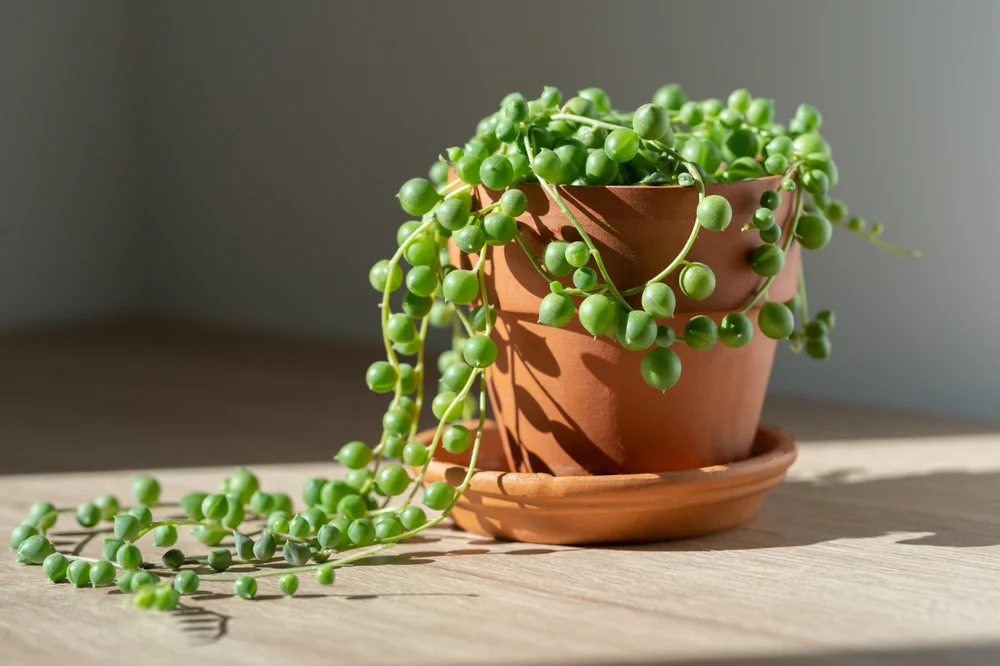Caring for the String of Pearls Plant

How to Arrange Plants in Your Living Room to Create the Perfect Harmony
June 26, 2024
Know and Grow the Schefflera Plant (Umbrella Plant)
June 28, 2024Overview
Caring for the String of Pearls Plant The String of Pearls (Senecio rowleyanus) is a unique and charming succulent known for its trailing vines adorned with spherical, bead-like leaves that resemble a string of pearls. Native to the arid regions of Southwest Africa, this plant is relatively easy to care for, making it a popular choice for both novice and experienced plant enthusiasts. Here’s a comprehensive guide to help you care for your String of Pearls plant.
Light Requirements
String of Pearls thrives in bright, indirect light. It can tolerate some direct sunlight, particularly in the morning or late afternoon, but too much direct sun can scorch the leaves. If kept indoors, place the plant near a window with filtered light or use sheer curtains to diffuse the sunlight. Insufficient light can cause the plant to become leggy and lose its characteristic spherical leaves.
Watering
As a succulent, String of Pearls is drought-tolerant and prefers to be on the drier side. Water thoroughly but infrequently. Allow the soil to dry out completely between waterings. Overwatering is a common mistake and can lead to root rot. In general, watering every two to three weeks is sufficient, but this can vary depending on the climate and the plant’s environment. During the winter months, reduce the frequency of watering.
Soil and Potting
A well-draining succulent or cactus potting mix is essential for String of Pearls. You can also create your own mix by combining regular potting soil with sand, perlite, or pumice to improve drainage. Choose a pot with drainage holes to prevent water from accumulating at the bottom, which can cause root rot. Repotting is typically only necessary every couple of years or if the plant outgrows its current container.
Temperature and Humidity
String of Pearls prefers temperatures between 70-80°F (21-27°C) during the growing season (spring and summer) and cooler temperatures, down to 50°F (10°C), during the dormant period (fall and winter). It can tolerate typical household humidity levels but prefers a dry environment. Avoid placing the plant in high humidity areas or near drafty windows and vents.
Fertilization
During the growing season, feed String of Pearls with a diluted, balanced liquid fertilizer every two to four weeks. Use a fertilizer specifically formulated for succulents and cacti. Do not fertilize during the dormant period in fall and winter, as the plant’s growth slows down, and excess nutrients can harm it.
Pruning and Propagation
Regular pruning helps maintain the plant’s shape and encourages fuller growth. Use clean, sharp scissors to trim back any leggy or unhealthy stems. The cuttings can be used for propagation. To propagate, place the cuttings in a well-draining soil mix and keep them slightly moist until roots develop, which typically takes a few weeks. Once rooted, they can be treated as mature plants.
Pests and Problems
String of Pearls is relatively pest-resistant but can occasionally suffer from common houseplant pests like aphids, mealybugs, and spider mites. Regularly inspect the plant and treat any infestations promptly with insecticidal soap or neem oil. Overwatering and poor drainage are the most common issues, leading to root rot. Ensuring proper watering practices and soil drainage can prevent these problems.
Tips for Success
- Rotate the plant occasionally to ensure even growth and light exposure.
- If the plant becomes leggy, it may not be receiving enough light. Adjust its location to provide brighter, indirect light.
- Allow the soil to dry out completely between waterings to mimic the plant’s natural arid environment.
- Avoid placing the plant in areas with high humidity or near air conditioning vents, as this can stress the plant.
By following these care guidelines, your String of Pearls plant will thrive, adding a touch of greenery and unique charm to your indoor space.

